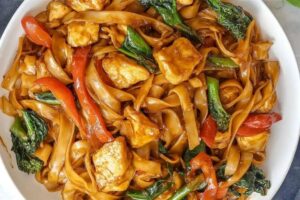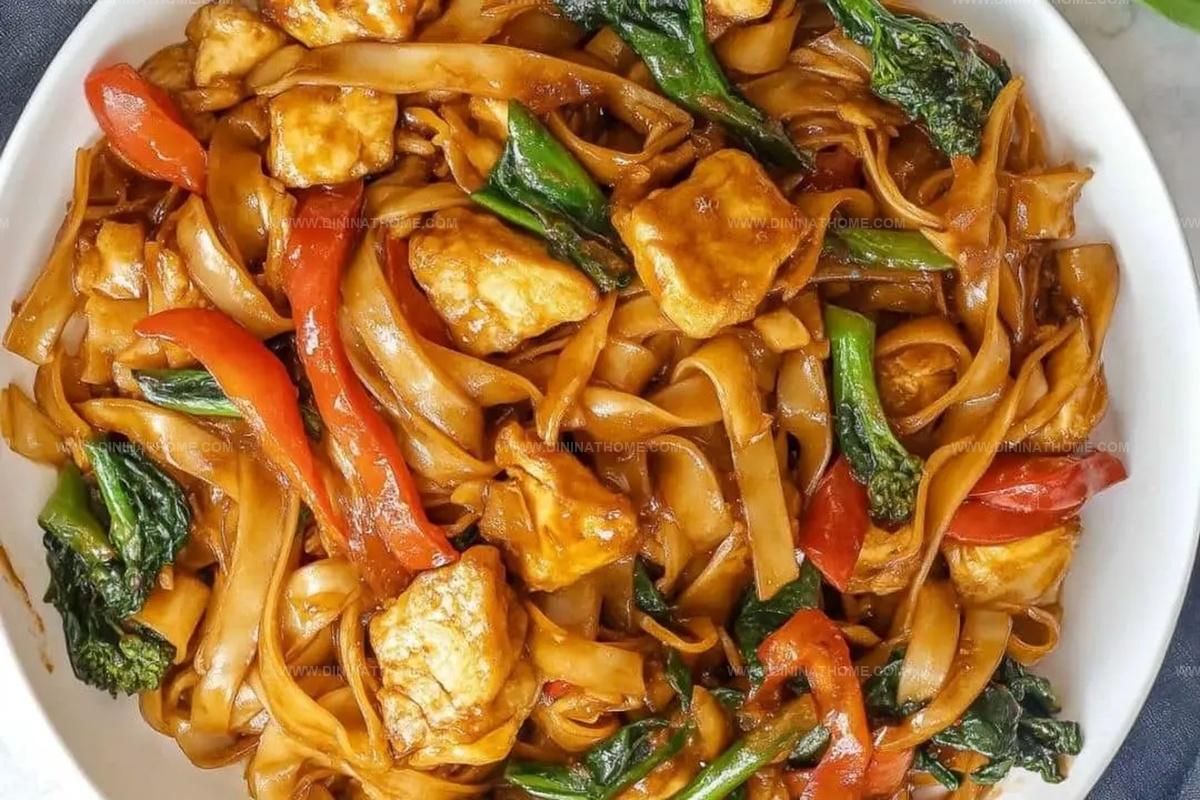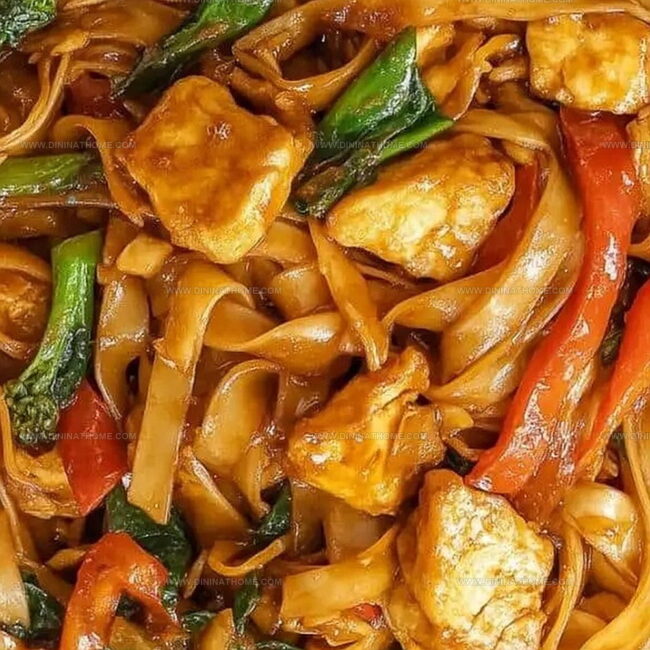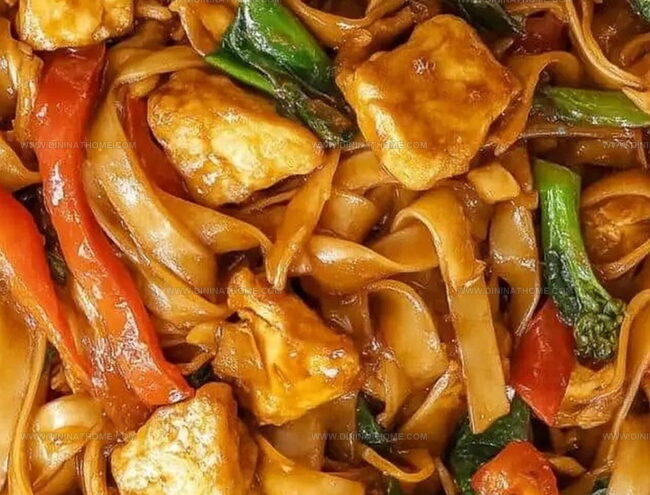Sizzling Drunken Noodles (Pad Kee Mao) Recipe to Spice Up Dinner
Simmering with bold thai street flavors, these drunken noodles dance across your plate with wild, passionate intensity.
Authentic ingredients spark an unforgettable culinary adventure through bangkok’s vibrant food landscape.
Thick rice noodles twist and embrace spicy chilies, creating a symphony of heat and texture.
Wok-charred edges bring smoky depth to each tantalizing bite.
Fragrant basil leaves scatter like emerald confetti, promising complex flavor layers.
Fresh vegetables add crisp counterpoints to the rich, savory sauce.
You’ll want chopsticks ready to dive into this incredible bangkok-inspired feast.
Drunken Noodles That Bring the Perfect Kick
Drunken Noodles – Everything You’ll Be Using
Main Ingredients:Aromatics and Flavor Builders:Sauce and Seasoning Components:Drunken Noodles Stir-Fry Steps
Step 1: Boil Rice Noodles
Bring a large pot of water to a rolling boil.
Add the fresh or dried rice noodles and cook until they’re just tender but still have a slight bite.
Drain the noodles immediately and rinse with cold water to stop the cooking process.
Set aside and let them drain completely while you prepare the other ingredients.
Step 2: Prep Protein and Vegetables
Slice your chosen protein (chicken, beef, or tofu) into thin, bite-sized pieces.
Chop the following ingredients:Step 3: Mix Flavor Sauce
In a small bowl, whisk together:Step 4: Heat Wok or Large Skillet
Place a wok or large skillet over high heat.
Add a generous splash of cooking oil and let it get super hot.
The pan should be smoking slightly before you start cooking.
Step 5: Sear Protein
Add the sliced protein to the hot pan.
Cook quickly, stirring constantly, until the meat is just cooked through and starts to develop a golden-brown exterior.
Step 6: Stir-Fry Aromatics
Toss in the chopped garlic and Thai chili peppers.
Stir-fry for about 30 seconds until fragrant, being careful not to burn the garlic.
Step 7: Add Vegetables
Throw in the chopped bell peppers and continue stir-frying for another minute.
The vegetables should remain crisp and vibrant.
Step 8: Combine Noodles and Sauce
Add the prepared rice noodles to the wok.
Pour the mixed sauce over the noodles and protein.
Toss everything together with quick, aggressive movements to ensure even coating.
Step 9: Final Touches
Sprinkle in the chopped green onions.
Give a final quick stir to heat through.
The entire cooking process should take no more than 3-4 minutes to keep the noodles and vegetables fresh and crisp.
Step 10: Serve Immediately
Transfer the drunken noodles to serving plates.
Garnish with extra fresh Thai basil leaves and additional sliced chili peppers if desired.
Serve hot and enjoy the bold, spicy flavors of this classic Thai street food.
Noodle Stir-Fry Tips for Drunken Noodle Dishes
Drunken Noodles Reheat Guide
Pairing Picks for Drunken Noodles
Drunken Noodles Stir-Fry Styles
FAQs
Thai basil, wide rice noodles, and a spicy-savory sauce with chili peppers are the signature elements that give this dish its authentic flavor and kick.
Despite its name, Drunken Noodles aren’t necessarily connected to drinking. The term refers to the bold, intense flavors that are supposedly good for curing a hangover.
The dish is typically quite spicy, with Thai chili peppers providing a significant heat level. Diners can adjust the spiciness by controlling the amount of chilies used in the recipe.
While chicken is most common, beef, shrimp, and tofu are excellent protein alternatives that work perfectly with the bold sauce and noodle combination.
Print
Drunken Noodles (Pad Kee Mao) Recipe
- Total Time: 30 minutes
- Yield: 2 1x
Description
Spicy Thai “Drunken Noodles” (pad kee mao) deliver a fiery flavor explosion that dances across your palate. Street-style Thai cuisine brings bold ingredients together in a sizzling wok, promising pure culinary excitement you’ll crave again and again.
Ingredients
Proteins:
- 1 lb protein of choice (chicken, beef, shrimp, tofu)
Noodles and Vegetables:
- 10 ounces (280 grams) wide rice noodles
- 1 bell pepper, sliced
- 1/2 small onion, sliced
- 4 cloves garlic, minced
- 23 Thai chilies, finely chopped (adjust for spice level)
- 1 cup fresh Thai basil leaves
Sauces and Seasonings:
- 2 tablespoons vegetable oil
- 2 tablespoons dark soy sauce
- 2 tablespoons light soy sauce
- 1 tablespoon oyster sauce
- 1 teaspoon fish sauce
- 1 teaspoon sugar
- 1/2 teaspoon black pepper
Instructions
- Soak rice noodles in warm water for 15-20 minutes until they become pliable and flexible, ensuring they’re soft but not completely mushy.
- Drain the noodles thoroughly and set aside, allowing excess water to drip off completely.
- Mince garlic, slice Thai chilies, and chop basil leaves into delicate ribbons, preparing them for quick integration into the dish.
- Heat a large wok or heavy skillet over high heat, creating an intensely hot cooking surface for rapid stir-frying.
- Add oil to the scorching pan, allowing it to shimmer and spread quickly across the cooking surface.
- Toss in minced garlic and sliced chilies, stirring vigorously to release their aromatic oils and prevent burning.
- Introduce protein of choice, breaking it into small pieces and searing until golden brown and partially cooked.
- Quickly add noodles to the wok, using tongs to separate and coat them with the fragrant oil and spices.
- Pour in soy sauce, oyster sauce, and fish sauce, creating a dynamic flavor base that coats every strand of noodle.
- Stir-fry the mixture aggressively, allowing the noodles to develop slight char marks and absorb the complex sauce.
- Incorporate fresh basil leaves, letting them wilt and release their herbaceous essence into the dish.
- Remove from heat immediately, transferring the steaming noodles to serving plates to prevent overcooking.
- Garnish with additional fresh basil and a sprinkle of crushed red pepper for an extra burst of flavor and heat.
Notes
- Use wide rice noodles for authentic texture, ensuring they’re fresh or properly soaked to prevent sticking.
- If rice noodles aren’t available, substitute with linguine or flat wheat noodles as a quick alternative.
- Rinse noodles in cold water after boiling to stop cooking and prevent them from becoming mushy.
- Pat noodles dry with paper towels to help them absorb the flavorful sauce more effectively.
- Prep Time: 10 minutes
- Cook Time: 20 minutes
- Category: Dinner
- Method: Boiling
- Cuisine: Thai
Nutrition
- Serving Size: 2
- Calories: 600
- Sugar: 3 g
- Sodium: 1200 mg
- Fat: 20 g
- Saturated Fat: 3 g
- Unsaturated Fat: 17 g
- Trans Fat: 0 g
- Carbohydrates: 85 g
- Fiber: 2 g
- Protein: 30 g
- Cholesterol: 70 mg




Emily Harper
Nutrition Consultant & Recipe Analyst
Expertise
Healthy Recipe Modification, Nutritional Analysis & Meal Planning, Global Cuisine & Dietary Adaptations
Education
School: French Pastry School, Chicago, IL
Program: L’Art de la Pâtisserie
Focus: Intensive training in traditional French pastry techniques, baking theory, and confectionery arts.
Emily’s journey started in a pastry kitchen but took a detour into the world of health and flavor science.
Graduating from the French Pastry School and studying nutrition opened her eyes to a new mission: making healthy food taste like something you’d actually crave.
At Dining At Home, Emily’s the go-to for smart, feel-good recipes that don’t trade flavor for nutrition.
She’s all about adding a fresh spin on old favorites and finding small ways to make everyday meals a little brighter.
Outside of the kitchen, Emily is most at home walking forest trails, testing plant-based recipes, or sharing a picnic under a wide-open sky.